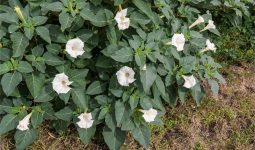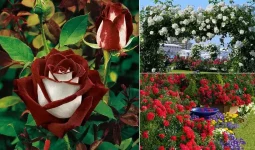Is your lush, thriving garden being turned into a palatable meal to munch on by deer? Then you need to check our list of the best deer tolerant plants to have in your garden.
These animals will eat just anything when hungry, so even a deer-resistant plant can still be targeted. Because of this, it’s important to consider how resilient your plants are and whether they can quickly recover from a deer munching session.
There are many wonderful deer tolerant plants to pick from, whether you’re looking for evergreen shrubs to form the foundation of your garden plan or annuals to fill in any gaps in pots and borders.
Read on to find out more about these plants, which add beauty and a bit of protection to your beloved beds. Consider the sun and soil requirements for each plant as you plan your garden. You’ll likely be able to design a deer-proof garden that blooms all year round.
1. Peonies
Peonies are one of the most long-lasting garden plants, often passed down from generation to generation. They come in various colors, such as coral, white, pink, rose, red, and deep purple. Their blooms resemble fluffy pom-poms. These top-heavy flowers frequently require staking and wind protection to prevent them from toppling over. They have a strong scent that deer avoid.
2. Bearded Iris
The bearded iris is a popular and easy-to-grow iris. They come in different colors, such as white, brown, pink, purple, blue, yellow, orange, and red. Its flowers have six spreading or drooping lobes and sword-like leaves.
The bearded iris prefers sunny conditions and well-draining soil, typically flowers in its first year. This plant is toxic to both cats and dogs. However, the flower’s fragrance is the main reason why deer stay away.
3. Monkshood
This is also among the best deer tolerant plants. Monkshood is a tall, herbaceous perennial flower that is native to Europe and Asia. It thrives in partial shade and blooms in the late summer and fall.
This slow-growing plant earned its name from resembling the cowl on a monk’s habit. It grows sturdy, unbranched stems covered in racemes of azure blue, pink, yellow, or white flowers. To thrive, it requires an abundance of water. This plant is toxic, which is probably why deer avoid it.
4. Red Twig Dogwood
The red twig dogwood is a deer-resistant shrub, but if a deer does try to eat it, the good news is that it grows quickly and can withstand severe pruning, so it will quickly recover.
They can adjust to various environmental conditions as they can thrive in full sun or partial shade. Maintain the shrub’s appearance by removing old or diseased canes.
Grow them in USDA zones 3–8, and look at various varieties of dogwoods, which range in size from medium shrubs to small trees.
5. Lily of the Valley
The lily of the valley belongs to the asparagus family and is not a true lily. It has lily-like leaves, soft, fragrant bell-shaped blooms in the spring, and orange-red berries in the autumn.
This ground cover gradually spreads and forms crowded colonies. In addition, this plant contains glycosides, which render all parts toxic to both humans and animals. You can grow them in USDA zones 5 to 9.
6. Butterfly Bush
Butterfly bush is among the best deer tolerant plants that produce eye-catching floral spikes or clusters in various colors that draw pollinators but repel deer. Some of these shrubs can reach heights of up to 12 feet, while others are more compact. It’s an Asian plant that easily reproduces by seed, and you can plant them in USDA zones 5 to 9.
7. Marigold
Marigolds are vibrant annuals that consistently bloom in shades of yellow, gold, and coppery hues with serrated, fern-like foliage. When planted from seed, these plants grow quickly and bloom within a few months. Their scent repels deer and rabbits; you can plant them in USDA zones 2 to 11.
8. Sunflower
Annual members of the aster family, sunflowers bloom in the middle of summer and continue through the beginning of fall. They’re among the best deer tolerant plants.
Its large flowers, which can reach six inches in width or more and have a noticeable central disk, mature into hundreds of seeds that birds adore. Sunflowers have hairy, sturdy, upright stems that can grow several feet tall, depending on the variety. You can also plant them in USDA zones 2 to 11.
9. Foxglove
Foxglove is a tall, flowering plant with striking, tubular blooms that are available in pink, white, or purple. It is a plant that grows quickly and gets as tall as 5 feet.
This biennial produces foliage in its first year and enormous flower stalks in its second year before it perishes. Self-seeding foxgloves continue to grow in a patch year after year. This plant is toxic to both plants and animals. You can plant in USDA zones 4 to 10.
10. Heliotrope
This beautiful flowering plant is among the best deer tolerant plants. These plants turn to face the sun because they adore it. The smell and the abrasive, sandpaper-like leaves turn deer off.
In warmer climates, they are grown as perennials, but in colder climates, they are frost-tender and grown as annuals. By deadheading, you can promote bushier, more dense growth and more blooms. Also, you can plant them in USDA zones 9 to 11.
11. Zinnia
Zinnias grow as perennials in warm climates but as annuals elsewhere. They don’t need much maintenance, but if plants aren’t spaced apart enough to allow for adequate air circulation, powdery mildew can become an issue.
These annuals with vibrant colors have flat flower heads that bloom from the summer into the fall. Deadheading faded blooms promote new blooms.
In addition, there are compact and tall varieties (up to 4 feet high), and you can plant them in USDA zones 2 to 11. Deer often avoid nibbling on the leaves due to their rough texture.
12. Lilac
The common lilac is a low-maintenance landscaping plant with a powerful fragrance and numerous clusters of colorful flowers. Deer tend to stay away from common lilacs, but young plants are particularly fragile right after planting.
As long as the root system is unharmed, the plant will live and grow again. This makes them one of the best deer tolerant plants, and you can grow them in USDA zones 3 to 7.
13. Forsythia
Forsythias are quick-growing flowering shrubs that are deciduous and belong to the olive family. These low-maintenance shrubs bloom in early spring before they leaf out.
Larger varieties of forsythia can grow up to ten feet tall, while compact varieties only reach a few feet tall. Although deer don’t often eat these, any plant that isn’t toxic is perfectly fine for a starving deer. They can grow well in USDA zones 5 to 8.
14. Rose of Sharon
This hibiscus specie grows showy five-petal blooms with a prominent stamen. It grows between one and two feet a year and can be planted in the spring or fall.
This shrub can withstand urban environments, heat, humidity, poor soil, and drought. You can rarely see it being damaged by deer, and it can be planted in USDA zones 5 to 8.
15. Floss Flower
The floss flower is also among the best deer tolerant plants. This annual blooms from late spring until the first fall frost. Some varieties can reach heights of 30 inches. Floss flower comes in various colors, but periwinkle blue is the most desirable.
Ageratum thrives in sunny spots with moist, well-draining soil. They can withstand periods of drought but perform best when watered regularly. Their rough texture foliage often keeps deer away. You can plant them in USDA zones 2 to 11.
16. Verbena
Pollinators like bees, hummingbirds, and butterflies love common garden verbena, but you shouldn’t have to worry about deer eating it. Although most verbena varieties are grown as annuals, they are hardy perennials in zones 8 to 11.
They produce clusters of vibrant flowers that bloom continuously from spring to fall. To promote new blooms and lengthen the blooming season, deadhead common garden verbena while it is still growing.
17. Snapdragon
This is also among the best deer tolerant plants. While grown as cool-weather annuals in other climates, snapdragons are short-lived garden perennials in USDA hardiness zones 8 through 11. They range in size and variety from spires that are only a few inches tall to those that are close to four feet tall.
The colorful blooms of snapdragons come in almost every hue and I prefer the cooler spring and fall months. When temperatures rise, flower production decreases.
18. Beebalm
Bee balm is a member of the mint family and a wildflower native to North America. It has long bloom seasons and colorful, vibrant flowers. You can plant them in USDA zones 3 to 9.
Bee balm is a weedy plant that can grow up to four feet tall and has downy oval leaves on the undersides. They frequently self-seed and spread quickly through underground rhizomes.
The flowers, which resemble vibrant, hairy clusters, are a favorite of hummingbirds and draw butterflies and bees. However, deers don’t like their scent.
19. Bleeding Heart
Among the best deer tolerant plants on this list is the bleeding heart. Bleeding hearts might resemble a deer’s meal with their delicate ferny foliage and pretty heart-shaped flowers that dangle from graceful, arching stems.
However, neither deer nor rabbits nor dense shade can stop these favorites’ spring blossom display. In addition, a bleeding heart will become dormant if exposed to excessive heat or sunlight. This deer-tolerant plant do well in USDA zones 3 to 9.
20. Coneflower
The non-aggressive self-seeding coneflower grows in the sun, or partial shade entices butterflies, nourishes bees and wild birds, and self-seeds.
This plant grows well in USDA 3 to 9. Coneflowers have longer blooming periods than many other perennials, which makes them a great option for perennial gardens. They can withstand heat and drought quite well.
21. Corydalis
Corydalis is also among the best deer tolerant plants. It is not your typical shade garden plant and stands out for its lovely fern-like foliage and prolonged blooming period.
They have blue or yellow blooms and will grow best in regions with cool summers. If planted in a favorable environment, corydalis can develop into a moderately aggressive self-sower. They do well in USDA zones 5 to 7.
22. Coreopsis
Deers rarely notice this plant. It’s simple to grow due to its drought tolerance and lack of fertilizer requirements. Deadheading spent blooms can produce more blooms later in the season, and you can plant them in USDA zones 4 to 9.
23. Daffodil
Deer, squirrels, and rabbits dislike the milky sap of the daffodil. Daffodils, unlike tulips, multiply over time. They are an essential part of any spring deer-proof garden, thanks to their new exciting double forms and pinky-salmon colors. This beautiful plant is hardy in USDA zones 3 to 8.
24. Lavender
This is also one of the best deer tolerant plants on this list. Deer despise what people find pleasing to their olfactory senses.
Both the lavender foliage and the blooms give off the sweet scent that potpourri makers adore. Lavender thrives in warmer climates where it can be grown into fragrant hedges; they have some difficulty in colder climates. You can grow them in USDA zones 5 to 9.
25. Vinca
Vinca, also referred to as the Madagascar periwinkle, may sound like an exotic hothouse flower, but thanks to its hardy nature and glossy green foliage, it can withstand deer, rabbits, and drought.
In addition, vinca plants should bloom from late spring until the first frost, though hot weather tends to increase flowering.
Give your flowers a balanced fertilizer every other week. They’re hardy in USDA zones 4 to 9, and deadheading isn’t necessary.
Conclusion
There you have it – 25 of the best deer tolerant plants. Protecting your garden from pests can be difficult, especially from large intruders like deer, but what you plant can definitely make a difference. So pick your choice from the list above and keep those pests out!








